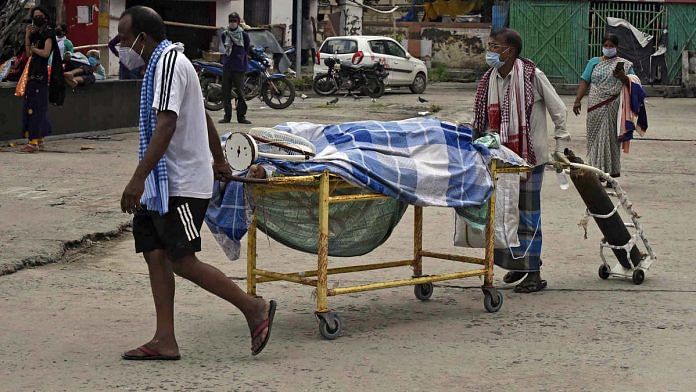New Delhi: The government of India has notified a change in post-mortem protocols that allows them to be conducted any time of the day, regardless of whether there is natural light available or not. This is, however, subject to the availability of appropriate infrastructure in hospitals where the autopsy is being conducted.
Officials in the Union Ministry of Health and Family Welfare said though there is no law barring post-sunset autopsies, the convention of conducting post-mortem examinations only in daylight was often used as an excuse to delay the procedure, especially in small towns.
The change in protocol in likely to make a lot of difference, not just to the families of the deceased — who often end up in an inordinate wait to get the body — but also to India’s organ donation programme.
Also read: ‘Don’t take your organs to heaven with you’ — Govt urges Indians on Organ Donation Day
The new protocol
A post-mortem examination, as the name suggests, is carried out by pathologists and forensic medicine doctors after a person has died, usually to ascertain the cause of death. Not all bodies are subjected to a post-mortem examination.
It is carried out only in those cases where the cause of death is not known, or the circumstances are suspicious, or if the death is sudden or violent.
In a statement issued Monday about the changed protocol, the ministry said the decision was taken in “response to the multiple references that have been received by the Union Health Ministry from various sources and in line with the government’s commitment to promote ease of living by reducing burden imposed due to compliance to government processes”. It said the new protocol allowing autopsies to be conducted after sunset is “effective from today”.
The statement said “apart from friends and relatives of the deceased, this new procedure also promotes organ donation and transplant as organs can be harvested in the stipulated time window after the procedure”.
The changes, however, come with some riders. In deaths where homicide, suicide or rape is suspected or alleged, or if the body is decomposed or there is suspected foul play, the dead bodies should only be examined during daylight hours. But in such cases, too, there is an exception — if the law and order situation is fragile, then the procedure can be expedited (which means the post-mortem exam can be conducted after daylight hours).
Also read: ‘Tough call but felt right’ — Delhi couple watched their 20-month-old die, & then save 5 lives
The importance of light
Light is important in post-mortem examinations because the colour of a wound, or of internal organs, can hold valuable insights into the cause of death.
In a 2005 paper in the Medical Journal of Armed Forces in India, Dr R.B. Kotabagi, then the head of the forensic medicine department in the Armed Forces Medical College, Pune, wrote: “A well-equipped autopsy room with efficient cold-storage facility is the basic infrastructure required.
“The autopsy room should have good natural lighting, exhaust ventilation, fly-proofing, running water supply, good drainage and an autopsy table with central drainage. Natural light is best as appreciation of different hues of colours is better. Hence as a rule, autopsy is not to be carried out at night under artificial lighting,” he added.
However, the genesis of this goes way back to British India, said former AIIMS director and forensic medicine expert Dr T.D. Dogra.
“Autopsies started some time in the 1860s. At that time, there was no electricity so post-mortems could not be carried out after sunset. Light is important for interpretation of wounds. But you have to understand that there is no order in writing. It is just a convention that has gone on,” he added.
He referred to his own paper on artificial lighting in autopsy rooms that was published in the Journal of Police Research and Development in 1984, to make the point that a light of 150 lumen (unit of brightness of light) on the table is sufficient to conduct an autopsy.
In fact, he said, in AIIMS New Delhi, autopsies were carried out in a basement, with artificial lighting, till the first half of the 2000s. “When I joined AIIMS in 1971, we only carried out autopsies with artificial lighting. Many states like Gujarat and Maharashtra have already issued notifications allowing 24/7 autopsies.”
Also read: AIIMS, Safdarjung Hospital begin testing bodies for Covid-19 before conducting autopsies
Implications for organ donation
Despite a large number of deaths caused by traffic accidents, cadaver donations in India have not picked up because of a variety of reasons. One of these is the daylight autopsy convention. At one point, it was even suggested that organ retrieval be carried out before autopsy to retain the viability of organs.
The ministry, in its statement Monday, said it was “ascertained that some institutes are already performing night-time post-mortem”.
“In view of the rapid advancement and improvement in technology, especially availability of required lighting and infrastructure required for post-mortem, performing night time post-mortem in hospitals is now feasible,” it added.
The protocol, it said, “stipulates that post-mortem for organ donation be taken up on priority and be conducted even after sunset at the hospitals which have the infrastructure for conducting such post-mortem on a regular basis”.
“The fitness and adequacy of infrastructure etc, shall be assessed by the hospital-in-charge to ensure that there is no dilution of evidentiary value. It is also to be ensured by the facility that video recording of post-mortem shall be done for all post-mortem conducted in the night, to rule out any suspicion and preserved for future reference for Legal purposes,” it added.
(Edited by Poulomi Banerjee)
Also read: A police surgeon writes about his first exhumation and post mortem — of a Malayali actress



